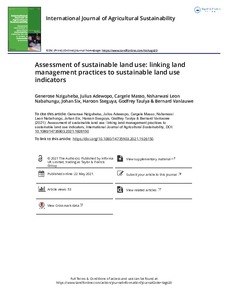| dc.contributor.author | Nziguheba, G. |
| dc.contributor.author | Adewopo, J. |
| dc.contributor.author | Masso, C. |
| dc.contributor.author | Nabahungu, N.L. |
| dc.contributor.author | Six, J. |
| dc.contributor.author | Sseguya, H. |
| dc.contributor.author | Taulya, G. |
| dc.contributor.author | Vanlauwe, B. |
| dc.date.accessioned | 2021-06-17T12:05:19Z |
| dc.date.available | 2021-06-17T12:05:19Z |
| dc.date.issued | 2021 |
| dc.identifier.citation | Nziguheba, G., Adewopo, J., Masso, C., Nabahungu, N.L., Six, J., Sseguya, H., ... & Vanlauwe, B. (2021). Assessment of sustainable land use: linking land management practices to sustainable land use indicators. International Journal of Agricultural Sustainability, 1-24. |
| dc.identifier.issn | 1473-5903 |
| dc.identifier.uri | https://hdl.handle.net/20.500.12478/7135 |
| dc.description.abstract | Land degradation threatens food production especially in smallholder farming systems predominant in sub-Saharan Africa. Monitoring the effects of agricultural land uses is critical to guide sustainable intensification (SI). There are various indicators of sustainable land use (SLU), but conventional methods to quantify their metrics are complex and difficult to deploy for rapid and large-scale assessments. Considering that SLU indicators are dependent on agricultural practices, which can be rapidly identified and quantified, we propose a framework for SLU assessment that includes indirect quantifications of prioritized indicators (crop productivity, soil organic carbon (SOC), acidification, erosion, nutrient balance) using agricultural practices; and a SLU index derived from the integration of these indicators. The application of the framework to a case study, consisting of 1319 farm plots in Tanzania, reveals that SOC and N balance were the main contributors to the SLU gap. Only 2.2% of the plots qualified as being used sustainably. The framework proved to be sensitive to practices commonly used by farmers, thus providing an opportunity to identify practices needed to revert land degradation. Further application of the framework as a decision-support tool can enhance the efficiency of SI investments, by targeting practices which effectively enhance food production and preserve land. |
| dc.description.sponsorship | United States Agency for International Development |
| dc.format.extent | 1-24 |
| dc.language.iso | en |
| dc.subject | Acidification |
| dc.subject | Erosion |
| dc.subject | Crops |
| dc.subject | Soils |
| dc.subject | Carbon |
| dc.subject | Crop Production |
| dc.subject | Sustainable Land Use |
| dc.title | Assessment of sustainable land use: linking land management practices to sustainable land use indicators |
| dc.type | Journal Article |
| cg.contributor.crp | Maize |
| cg.contributor.crp | Roots, Tubers and Bananas |
| cg.contributor.crp | Policies, Institutions and Markets |
| cg.contributor.affiliation | International Institute of Tropical Agriculture |
| cg.contributor.affiliation | ETH Zurich |
| cg.coverage.region | Africa |
| cg.coverage.region | East Africa |
| cg.coverage.country | Ethiopia |
| cg.coverage.hub | Eastern Africa Hub |
| cg.coverage.hub | Central Africa Hub |
| cg.researchtheme | Natural Resource Management |
| cg.researchtheme | Plant Production and Health |
| cg.isijournal | ISI Journal |
| cg.authorship.types | CGIAR and advanced research institute |
| cg.iitasubject | Crop Husbandry |
| cg.iitasubject | Crop Systems |
| cg.iitasubject | Soil Fertility |
| cg.journal | International Journal of Agricultural Sustainability |
| cg.notes | Open Access Article; Published online: 22 May 2021 |
| cg.accessibilitystatus | Open Access |
| cg.reviewstatus | Peer Review |
| cg.usagerightslicense | Creative Commons Attribution 4.0 (CC BY 0.0) |
| cg.targetaudience | Scientists |
| cg.identifier.doi | http://dx.doi.org/10.1080/14735903.2021.1926150 |
| cg.iitaauthor.identifier | Generose Nziguheba: 0000-0003-4227-2242 |
| cg.iitaauthor.identifier | Julius Adewopo: 0000-0003-4831-2823 |
| cg.iitaauthor.identifier | Cargele Masso: 0000-0002-3980-6832 |
| cg.iitaauthor.identifier | Nsharwasi Nabahungu: 0000-0002-2104-3777 |
| cg.iitaauthor.identifier | Haroon Sseguya: 0000-0001-9963-3147 |
| cg.iitaauthor.identifier | Godfrey Taulya: 0000-0002-5690-0492 |
| cg.iitaauthor.identifier | bernard vanlauwe: 0000-0001-6016-6027 |
| cg.futureupdate.required | No |
| cg.contributor.acknowledgements | We extend our gratitude to all farmers who participate in the interview. We thank Henry Mwololo for his support in data processing. We are grateful to the Belgium Directorate General for Development Cooperation, the International Fund for Agricultural Development, and the Bill and Melinda Gates Foundation for support to projects covering sustainable land use activities. The case study was hosted by Africa RISING-NAFAKA partnership project funded by USAID Feed the Future program. |

